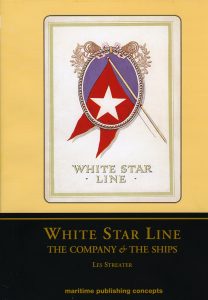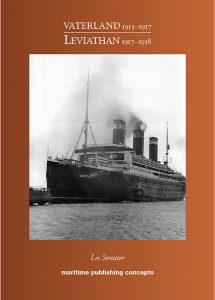 Clearing out the warehouse to make room for new stock, we found two boxes of mint copies of this book from 1997! Rarely available even from second-hand bookshops, this is a chance for you to acquire your own copy at less than the original cover price.
Clearing out the warehouse to make room for new stock, we found two boxes of mint copies of this book from 1997! Rarely available even from second-hand bookshops, this is a chance for you to acquire your own copy at less than the original cover price.
This is a paperback book covering the design, construction and service of Cunard’s four-funnelled express liner Aquitania. Published in 1997, this is smaller than our newer offering but still very detailed book about this beautiful liner. In 72 packed pages, every facet of the liner’s construction and service are covered.
Her first three commercial North Atlantic crossings in 1914 were a triumph. Then Aquitania proudly gave four years of service to her country, as an armed merchant cruiser, then a troopship and a hospital ship.
Aquitania’s peacetime service
Aquitania resumed her peacetime service and quickly became popular. Although she never fought for the Blue Riband, she was still one of the fastest liners on the route. Increasing US immigration restrictions, Prohibition, the Great D
World War II
With the advent of yet another war, she was soon requisitioned as a troopship, giving six years of hard work around the world.
Her last few years were spent repatriating American and Canadian troops, German prisoners of war and war brides, before taking emigrants to their new lives in a new world. She was finally scrapped in 1950.
72 pages. £10.00 plus shipping
CLICK HERE TO RETURN TO OVERVIEW PAGE

 The origins of White Star Line can be traced back to 1846. T.H. Ismay bought the company in 1868, registering it as Oceanic Steam Navigation, trading as White Star. He forged agreements with Harland & Wolff in Belfast to build his ships, which quickly gained a reputation for speed, comfort and reliability. The company grew and prospered, building ever bigger and better ships.
The origins of White Star Line can be traced back to 1846. T.H. Ismay bought the company in 1868, registering it as Oceanic Steam Navigation, trading as White Star. He forged agreements with Harland & Wolff in Belfast to build his ships, which quickly gained a reputation for speed, comfort and reliability. The company grew and prospered, building ever bigger and better ships.
 A hardback book covering the design, construction and service of White Star Line’s express liner Majestic.
A hardback book covering the design, construction and service of White Star Line’s express liner Majestic. A hardback book covering the design, construction and service of America’s first superliner, Leviathan.
A hardback book covering the design, construction and service of America’s first superliner, Leviathan.